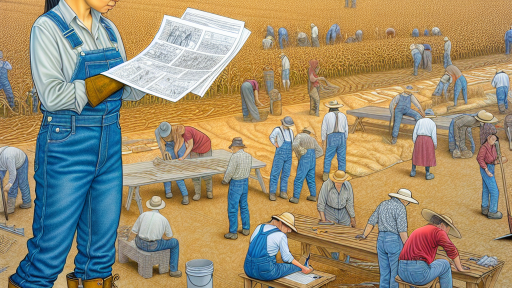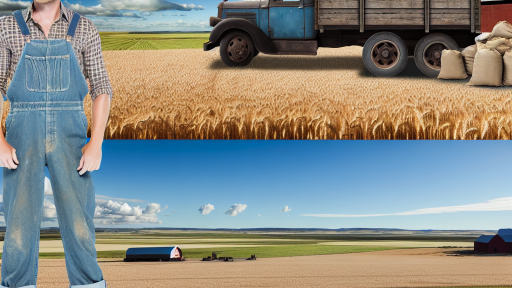Introduction to Agricultural Employment Law
Agricultural employment law encompasses various regulations impacting workers in the farming sector.
This area of law is significant for both employers and employees in agriculture.
Understanding agricultural employment law ensures compliance with safety, labor, and environmental regulations.
Importance of Agricultural Employment Law
Labor laws protect the rights of farm workers and ensure fair treatment.
These laws help prevent exploitation and promote better working conditions.
Moreover, they foster a stable workforce within the agricultural sector.
In addition, regulatory compliance helps farmers avoid penalties and legal disputes.
Scope of Agricultural Employment Law
The scope of agricultural employment law varies by region and jurisdiction.
Many laws focus on wage regulations, safety standards, and worker benefits.
Each state may have specific statutes governing agricultural employment practices.
Additionally, federal laws play a significant role in protecting workers’ rights.
Key Considerations
- Wage and Hour Standards: These regulations ensure fair compensation for workers.
- Health and Safety Regulations: Employers must provide a safe work environment.
- Anti-Discrimination Laws: Protections against discrimination in hiring and employment.
Challenges in Compliance
Compliance can be challenging due to fluctuating regulations.
Farmers may struggle to stay updated on changing laws.
Moreover, legal interpretations can vary, leading to confusion.
As a result, seeking legal advice is often beneficial.
Transform Your Agribusiness
Unlock your farm's potential with expert advice tailored to your needs. Get actionable steps that drive real results.
Get StartedKey Legislation Affecting Agricultural Employment: An Overview
Fair Labor Standards Act
The Fair Labor Standards Act (FLSA) sets minimum wage standards.
It also establishes overtime pay requirements for agricultural workers.
This legislation aims to protect workers from exploitation.
Moreover, the FLSA includes child labor provisions.
These provisions ensure youth workers are treated fairly.
Occupational Safety and Health Act
The Occupational Safety and Health Act (OSHA) promotes workplace safety.
It establishes standards to protect agricultural workers from hazards.
Additionally, OSHA requires employers to provide safety training.
This training helps prevent injuries in the agricultural sector.
Immigration and Nationality Act
The Immigration and Nationality Act (INA) affects agricultural employment.
This act outlines regulations for hiring foreign workers.
It emphasizes the importance of verifying worker eligibility.
Farmers often rely on seasonal workers through the H-2A visa program.
National Labor Relations Act
The National Labor Relations Act (NLRA) ensures employees’ rights.
This act allows agricultural workers to join unions.
Consequently, workers can collectively bargain for better conditions.
The NLRA protects employees from unfair labor practices.
State-Specific Labor Laws
Individual states often have their own labor laws.
These laws can provide additional protections for agricultural workers.
Farmers must comply with both federal and state regulations.
Understanding state-specific laws is essential for compliance.
Labor Rights for Agricultural Workers: Understanding Fair Treatment
Importance of Labor Rights
Labor rights protect agricultural workers from exploitation.
These rights ensure fair wages and safe working conditions.
Furthermore, recognizing these rights promotes dignity and respect.
Showcase Your Farming Business
Publish your professional farming services profile on our blog for a one-time fee of $200 and reach a dedicated audience of farmers and agribusiness owners.
Publish Your ProfileLegal Protections for Agricultural Workers
Various laws safeguard the rights of agricultural workers.
The Fair Labor Standards Act establishes minimum wage for all workers.
Moreover, the Migrant and Seasonal Agricultural Worker Protection Act provides essential protections for seasonal workers.
Understanding the Fair Labor Standards Act
The Fair Labor Standards Act sets a federal minimum wage.
It also regulates overtime pay for workers in agriculture.
However, exceptions exist for certain types of employees.
Migrant and Seasonal Agricultural Worker Protection Act
This act specifically addresses the needs of migrant workers.
It mandates disclosure of employment terms to workers.
Additionally, it offers protections against wage theft.
Challenges Faced by Agricultural Workers
Agricultural workers often encounter several challenges.
Many lack access to essential benefits like health care.
Additionally, they may experience language barriers in the workplace.
Fear of retaliation can prevent workers from voicing complaints.
Organizations Supporting Agricultural Workers
Several organizations advocate for agricultural workers’ rights.
The United Farm Workers has been a longstanding champion.
Additionally, local advocacy groups provide resources and support.
Steps for Enhancing Fair Treatment
Employers should actively promote workers’ rights.
Offering training on rights and benefits is crucial.
Regularly reviewing policies can ensure compliance with laws.
Employers must foster a culture of respect in the workplace.
Delve into the Subject: Understanding GMO Farming Regulations for Better Yields
Wages and Compensation in Agriculture
Minimum Wage Laws
Minimum wage laws set the baseline for worker compensation.
These laws vary by state and can change frequently.
Employers must stay updated on local wage requirements.
For instance, states like California have higher minimum wages than federal standards.
Employers must pay no less than the applicable minimum wage.
Failing to do so can lead to significant penalties.
It’s crucial for agricultural workers to know their rights.
They should be aware of their state’s specific minimum wage laws.
Overtime Regulations
Overtime regulations apply to many agricultural workers.
Typically, workers must receive time and a half for hours worked over 40 in a week.
However, some exemptions exist in the agricultural sector.
For example, seasonal farm workers may have differing rules.
Employers must carefully track worker hours to comply with regulations.
Not doing so can result in wage disputes and legal issues.
Employer Responsibilities
Employers have clear responsibilities concerning wages.
They must inform employees about the pay structure upfront.
This includes details about overtime and minimum wage policies.
Documentation of work hours is crucial for payroll management.
Furthermore, employers should maintain transparency with employees.
Showcase Your Farming Business
Publish your professional farming services profile on our blog for a one-time fee of $200 and reach a dedicated audience of farmers and agribusiness owners.
Publish Your ProfileOpen communication can prevent misunderstandings regarding pay.
Employees’ Rights
Employees in agriculture have the right to fair compensation.
They can file complaints if they believe they are underpaid.
It’s essential for employees to document their hours and pay stubs.
Taking these steps can provide valuable evidence if disputes arise.
Workers can seek assistance from labor unions and organizations.
These groups often provide resources to help navigate wage issues.
Explore Further: Protecting Farm Workers Legal Guidelines
Health and Safety Regulations in Agricultural Workplaces
Importance of Compliance
Compliance with health and safety regulations protects workers in agricultural settings.
It ensures that employers create safe working environments for employees.
Moreover, compliance minimizes the risk of accidents and injuries on the job.
Failing to comply can lead to serious legal consequences for agricultural businesses.
Key Regulations to Follow
Understanding key regulations is crucial for all agricultural employers.
The Occupational Safety and Health Administration (OSHA) sets forth essential guidelines.
These guidelines include proper training and safety measures.
Additionally, specific agricultural standards focus on machinery and pesticide use.
Personal Protective Equipment
Employers must provide appropriate personal protective equipment (PPE) to employees.
PPE includes gloves, masks, and eye protection, among other items.
This equipment helps reduce exposure to hazardous conditions.
Machine Safety Standards
Safety regulations include strict standards for machinery operations.
Employers must ensure that equipment is regularly maintained and inspected.
Training is also necessary to prevent accidents when using machinery.
Best Practices for Agricultural Employers
Implementing best practices can significantly enhance workplace safety.
Regular safety training sessions keep workers informed about hazards.
Additionally, conducting routine safety audits identifies potential issues.
Employers should promote an open-door policy for safety concerns.
Creating a Safety Plan
A comprehensive safety plan is essential for any agricultural operation.
This plan should outline procedures for various emergencies.
Furthermore, it should include protocols for reporting accidents and injuries.
Encouraging Employee Participation
Engaging employees in safety discussions fosters a proactive safety culture.
Workers should feel empowered to voice concerns about their safety.
Ultimately, collaboration leads to a more effective safety environment.
Enhancing Workplace Safety
Staying compliant with health and safety regulations protects workers.
Following best practices enhances overall safety in agricultural workplaces.
These efforts not only benefit employees but also strengthen the business.
Gain More Insights: Addressing Wage Theft in Agriculture
Worker Classification in Agriculture: Employees vs. Independent Contractors
Understanding Worker Classification
Worker classification significantly impacts agricultural employment law.
Employers must accurately classify their workers to comply with legal requirements.
Misclassification can lead to serious financial consequences and legal issues.
Defining Employees and Independent Contractors
Employees work under the direction of an employer.
Showcase Your Farming Business
Publish your professional farming services profile on our blog for a one-time fee of $200 and reach a dedicated audience of farmers and agribusiness owners.
Publish Your ProfileThey receive wages, benefits, and protections under various labor laws.
Independent contractors operate their own businesses.
They provide specific services to clients and have more control over their work.
Criteria for Classification
Several factors determine whether a worker is an employee or an independent contractor.
The IRS uses the common law test to assess classification.
This test evaluates the level of control an employer has over the worker.
Other criteria include the worker’s investment in tools and the opportunity for profit or loss.
Control and Independence
The degree of control varies between employees and independent contractors.
Employers have significant control over employees’ work processes and schedules.
Conversely, independent contractors maintain their own schedules and work methods.
Financial Considerations
Independent contractors typically take on more financial risk.
They invoice for their services and handle their own business expenses.
In contrast, employees are compensated through regular wages and benefits.
Legal Implications of Misclassification
Misclassifying workers can expose employers to legal penalties.
Employers may face fines for failing to pay overtime or provide benefits.
Additionally, misclassification can result in lost tax revenue for the state.
Best Practices for Compliance
Employers should evaluate their workforce regularly to ensure compliance.
Clear contracts clearly defining the nature of the relationship help avoid confusion.
Moreover, providing training on classification issues can reduce misclassification risks.
Uncover the Details: Understanding Water Rights in Agriculture

Discrimination and Harassment in Agricultural Employment
Legal Framework
Federal laws protect workers from discrimination and harassment in agriculture.
The Equal Employment Opportunity Commission (EEOC) enforces these laws.
Title VII of the Civil Rights Act prohibits employment discrimination.
This law covers race, color, religion, sex, and national origin.
Additionally, workers are protected under the Age Discrimination in Employment Act.
This act safeguards individuals aged 40 and older from discrimination.
Also, the Americans with Disabilities Act offers protections for disabled workers.
Harassment Defined
Harassment includes unwelcome conduct based on protected characteristics.
This conduct can create a hostile work environment.
It can also affect an employee’s ability to perform their job.
Importantly, employers must take immediate action to stop harassment.
Reporting Procedures
Agricultural workers should report instances of discrimination or harassment.
Employers must establish clear reporting procedures.
These procedures should ensure confidentiality and protection against retaliation.
Employees can also file complaints with the EEOC if necessary.
Employer Responsibilities
Employers must provide a workplace free from discrimination and harassment.
This includes training employees on their rights and responsibilities.
Moreover, they must investigate complaints promptly and thoroughly.
Failure to act can lead to serious legal consequences for employers.
Resources for Workers
Workers facing discrimination can access various resources for assistance.
Showcase Your Farming Business
Publish your professional farming services profile on our blog for a one-time fee of $200 and reach a dedicated audience of farmers and agribusiness owners.
Publish Your ProfileThe EEOC has a wide range of information on rights and reporting.
Local advocacy groups also provide guidance and support.
Furthermore, legal aid organizations can help workers understand their options.
Legal Resources and Support for Agricultural Workers
Understanding Agricultural Employment Rights
Agricultural workers must understand their employment rights clearly.
Familiarity with these rights ensures fair treatment in the workplace.
Organizations like the National Farmworker Ministry provide valuable resources.
Workers can access information about their rights through local agencies.
Finding Legal Assistance
Legal aid is crucial for resolving disputes in agricultural work settings.
One can seek help from organizations such as Farmworker Legal Services.
Local bar associations often have pro bono programs for agricultural workers.
Additionally, many law schools offer clinics focusing on agricultural law.
Government Resources
Various government agencies provide assistance for agricultural employees.
The U.S. Department of Labor offers guidelines and support for workers.
Workers can file complaints regarding labor violations with this department.
State-specific resources often exist for targeted assistance in local areas.
Worker Advocacy Groups
Advocacy groups play a significant role in supporting agricultural workers.
Organizations like the United Farm Workers focus on labor rights and issues.
They provide training and resources to help workers understand their rights.
Moreover, these groups often organize campaigns for better working conditions.
Safety and Health Resources
Ensuring workplace safety is a top priority for agricultural workers.
The Occupational Safety and Health Administration (OSHA) provides safety guidelines.
Workers can report unsafe conditions to OSHA for immediate action.
Additionally, training programs are available to help workers recognize hazards.
Networking and Community Support
Joining local worker centers can create a supportive network.
These centers offer workshops and resources to enhance worker knowledge.
Networking helps workers share experiences and solutions to common issues.
Community events often foster connections among agricultural workers.
Future Trends in Agricultural Employment Law: Challenges and Opportunities
Emerging Technologies
Emerging technologies transform agricultural practices every day.
Automation and robotics offer efficiency and precision.
However, they also raise employment questions.
Many workers fear job displacement due to technology.
On the other hand, technology creates new job categories.
For example, data analysis roles are increasingly necessary.
Thus, legal frameworks must adapt to these shifts.
Worker Rights and Protections
Worker rights remain a pivotal focus in agricultural employment law.
Recent movements advocate for better working conditions.
Farmworker organizations emphasize the need for protections.
Legal standards may need adjustment to reflect modern realities.
Issues like overtime pay and health benefits are critical.
In particular, seasonal workers often lack adequate protections.
Showcase Your Farming Business
Publish your professional farming services profile on our blog for a one-time fee of $200 and reach a dedicated audience of farmers and agribusiness owners.
Publish Your ProfileImmigration Policies
Immigration policies significantly impact agricultural labor supply.
Many farms rely on migrant workers for seasonal tasks.
Changes in immigration law can create labor shortages.
Employers must navigate shifting regulations carefully.
Furthermore, legal challenges may arise from immigration enforcement.
Environmental Regulations
Environmental concerns shape agricultural practices and labor laws.
Regulations promote sustainable farming methods.
This shift requires training for existing workers.
Farmers may face legal repercussions for non-compliance.
Consequently, education on environmental law becomes essential.
Labor Market Dynamics
The agricultural labor market faces constant evolution.
Competition for workers is intensifying across industries.
Aging farm populations lead to workforce shortages.
At the same time, younger generations seek different careers.
Consequently, farms must offer competitive wages and benefits.
Legal initiatives can support fair wage policies.
Global Trade Impacts
International trade agreements change agricultural employment landscapes.
Tariffs and trade policies influence market stability.
These factors can affect labor demand and job security.
Employers must remain aware of global economic shifts.
Trade negotiations often include labor rights considerations.
Additional Resources
Employment Law Guide: Laws, Regulations, and Technical …
Summary of the Major Laws of the Department of Labor | U.S. …




